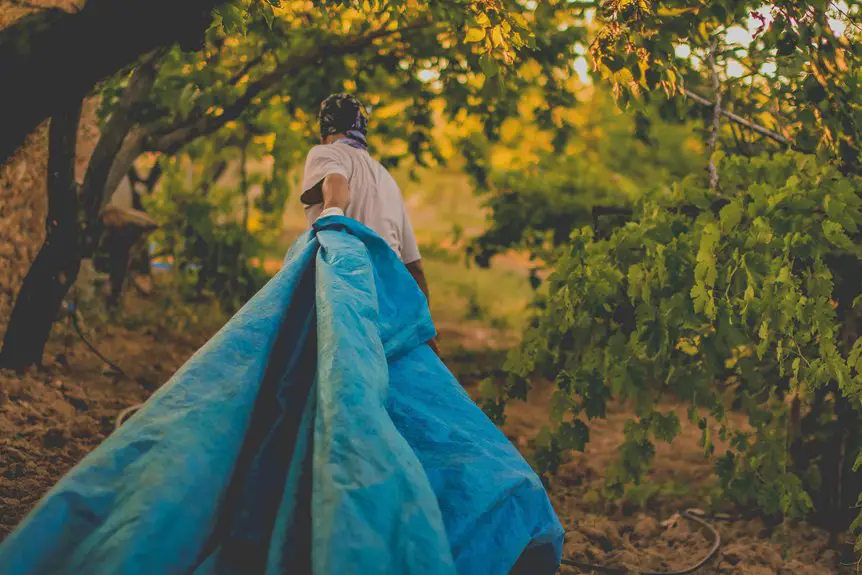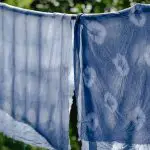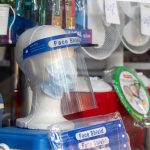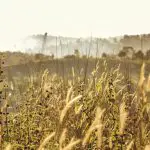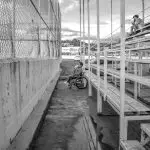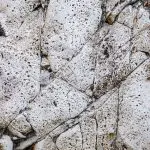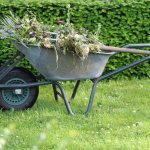You should pick woven landscape fabric if you need strong, tear-resistant material that handles foot traffic and sunlight well, blocking weeds while allowing air and water flow. If your garden deals with heavy rain or soil erosion, nonwoven fabric offers superior water drainage and soil stabilization but wears out faster in sunlight and is less durable. Knowing your garden’s conditions will help you decide which fabric fits best for lasting weed control and plant health. Explore the details to find the perfect match.
Table of Contents
Key Takeaways
- Choose woven fabric for superior strength, tear resistance, and durability in high-traffic or harsh weather garden areas.
- Opt for nonwoven fabric when prioritizing water drainage, soil stabilization, and ease of installation in heavy rainfall zones.
- Woven fabric allows better airflow, reducing soil compaction and supporting healthier plant roots over time.
- Nonwoven fabric’s softer texture suits erosion control and under-mulch use but may degrade faster under UV exposure.
- Consider terrain and garden layout: woven fabric is less flexible for irregular shapes, while nonwoven fabric adapts easily.
What Is Woven Landscape Fabric?
Woven landscape fabric is a durable material made by weaving polypropylene or polyester fibers together. When you lay it down, you’ll find it offers excellent strength and tear resistance, making it ideal for long-term garden use.
Its tightly woven structure lets water and nutrients pass through while blocking most weeds from growing. You’ll appreciate how easy it’s to cut and fit around plants or garden features.
Plus, it’s UV resistant, so it won’t break down quickly under sunlight. Because of its durability, you can expect it to last several years before needing replacement.
If you want a reliable barrier that balances permeability with toughness, woven landscape fabric is a smart choice for managing weeds and protecting your soil effectively.
What Is Nonwoven Landscape Fabric?
Nonwoven landscape fabric is made from fibers bonded together rather than woven threads.
You’ll often find it used for erosion control, weed suppression, and soil stabilization.
Understanding its material and common applications helps you choose the right fabric for your garden needs.
Material Composition
Landscape fabric made from nonwoven materials offers a unique blend of durability and permeability that suits various gardening needs. Unlike woven fabric, nonwoven landscape fabric consists of fibers that are bonded together using heat, chemicals, or adhesives rather than being woven or knitted.
This construction creates a dense, felt-like texture that blocks weeds while allowing water and air to pass through.
Here’s what you need to know about its material composition:
- Typically made from polypropylene or polyester fibers
- Fibers are randomly oriented and compressed
- Bonded using heat or chemical treatments
- Creates a thick, porous barrier
- Resistant to tearing and UV damage
This composition helps you control weeds without sacrificing soil health or moisture flow.
Common Applications
If you want to keep your garden neat and healthy, this fabric offers excellent weed control while letting water and air reach the soil. Nonwoven landscape fabric works well under mulch in flower beds and vegetable gardens, preventing weeds without suffocating your plants.
You can also use it in erosion control on slopes, as its dense structure holds soil in place while allowing moisture to pass through. It’s perfect for pathways and playgrounds too, providing a stable base that reduces weed growth.
Plus, nonwoven fabric suits areas with heavy rainfall since it drains water efficiently. Whether you’re landscaping a backyard or managing a commercial site, this fabric’s versatility helps maintain healthy soil conditions and reduces maintenance effort.
Key Differences Between Woven and Nonwoven Fabrics
Although both types serve similar purposes in gardening, woven and nonwoven fabrics differ considerably in structure and function.
Woven and nonwoven fabrics share uses but differ greatly in their structure and function.
When choosing between them, you’ll notice these key differences:
- Construction: Woven fabrics interlace fibers for tight, durable sheets; nonwoven fabrics bond fibers randomly.
- Durability: Woven fabrics tend to be stronger and resist tearing better.
- Water permeability: Nonwoven fabrics allow water to pass through more easily.
- Breathability: Woven fabrics offer better airflow, reducing soil compaction.
- Texture: Nonwoven fabrics feel softer and less rigid compared to the rougher woven type.
Understanding these distinctions helps you pick the right fabric for your landscape needs, balancing durability with water and air flow for healthy plants.
Pros and Cons of Woven Landscape Fabric
When choosing woven landscape fabric, you’ll notice it’s known for its durability and strength, making it great for long-term use.
However, you might wonder how well it allows water to pass through, which is essential for your plants.
Let’s explore the pros and cons of this fabric to help you decide if it fits your garden’s needs.
Durability and Strength
Because woven landscape fabric is crafted from tightly interlaced fibers, it offers impressive durability and strength that can withstand heavy foot traffic and harsh weather conditions.
When you choose woven fabric, you get a material that resists tearing and punctures better than many alternatives. This durability means it stays functional longer, saving you time and money on replacements.
However, keep in mind that while strong, it can be less flexible, making installation around irregular shapes a bit tricky.
Here’s what you can expect with woven fabric’s durability and strength:
- High resistance to ripping and tearing
- Withstands frequent foot traffic
- Durable against UV exposure
- Less stretch, so it holds shape well
- May be harder to mold on uneven terrain
This makes woven fabric a solid choice if strength is your top priority.
Water Permeability
Woven landscape fabric’s strength also affects how water moves through it, which is a key factor to contemplate for your garden’s health.
Because it’s tightly woven, it generally offers excellent water permeability, allowing rain and irrigation to pass through easily while preventing soil erosion. This means your plants get the moisture they need without water pooling on the surface.
However, some woven fabrics can be so dense that they slow down water flow, especially during heavy rain, which might cause temporary runoff. You’ll want to choose a fabric with the right balance—one that blocks weeds but lets water through efficiently.
Pros and Cons of Nonwoven Landscape Fabric
Although nonwoven landscape fabric offers excellent water permeability and soil stabilization, it comes with both advantages and drawbacks you should consider before choosing it for your garden.
You’ll appreciate its ability to prevent soil erosion and allow water to drain efficiently, but it may not be as durable as woven options.
Here are some pros and cons to keep in mind:
- Pros:
- Superior water drainage
- Effective soil stabilization
- Easy to install and cut
- Good for areas with heavy rainfall
- Helps reduce weed growth
- Cons:
- Less tear-resistant
- Can degrade faster under UV exposure
- May allow some fine weeds to grow
- Not ideal for high-traffic zones
- Generally less durable than woven fabric
Weigh these factors carefully to decide if nonwoven fabric fits your landscape needs.
How to Choose the Right Fabric for Your Garden Needs
When selecting landscape fabric, you’ll want to contemplate factors like durability, water drainage, and the specific conditions of your garden.
If your garden faces heavy foot traffic or harsh weather, woven fabric offers superior strength and longevity. On the other hand, if moisture retention and quick water flow are priorities, nonwoven fabric’s excellent drainage and breathability make it ideal.
Consider the types of plants you’re growing—some require better aeration, which nonwoven fabric provides. Also, evaluate how much weed control you need; woven fabric’s tight weave often blocks weeds more effectively.
Ultimately, choose a fabric that balances your garden’s needs with ease of installation and maintenance. By matching fabric features to your garden’s demands, you’ll create a healthier, more manageable landscape.
Frequently Asked Questions
Can Landscape Fabric Be Recycled After Use?
You can’t usually recycle landscape fabric because it’s made from mixed plastics. Instead, you’d better reuse it in your garden or dispose of it properly to avoid environmental harm. Check local rules for recycling options.
How Long Does Landscape Fabric Typically Last in Harsh Climates?
Oh, it’s practically immortal in harsh climates—said no landscape fabric ever. You’ll get about 3-5 years before sun, wind, and rain turn it into a sad, tattered mess begging for replacement.
Are There Eco-Friendly Alternatives to Synthetic Landscape Fabrics?
You can choose eco-friendly alternatives like biodegradable fabrics made from jute, coir, or cotton. These break down naturally, reducing waste and supporting soil health while still controlling weeds effectively in your garden or landscape.
Can Landscape Fabric Affect Soil Ph or Nutrient Levels?
Think of landscape fabric as a shield; it rarely changes soil pH or nutrients directly. However, by blocking organic matter, it can indirectly influence soil health, so you should monitor and amend your soil regularly for balance.
How Do You Properly Dispose of Old Landscape Fabric?
You should remove the old fabric carefully, shake off soil, and check local recycling rules. If recycling isn’t an option, dispose of it in your regular trash. Avoid burning it to prevent toxic fumes.
- What Is a Nonwoven Textile? a Broad Definition - July 9, 2025
- What Is a Nonwoven Textile? a Broad Definition - July 9, 2025
- What Is a Nonwoven Textile? a Broad Definition - July 9, 2025

